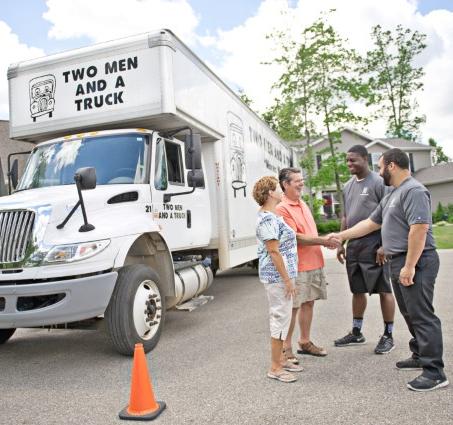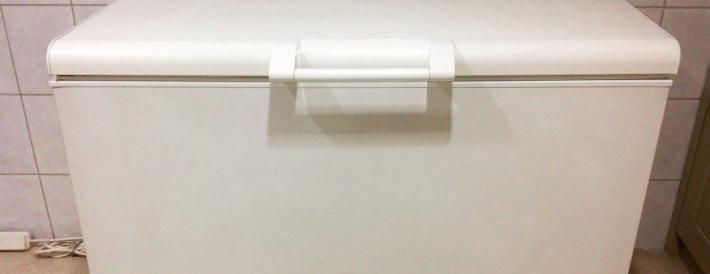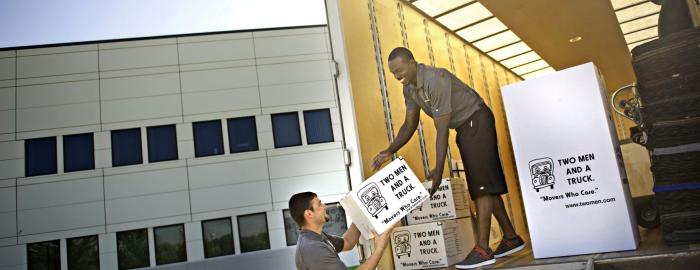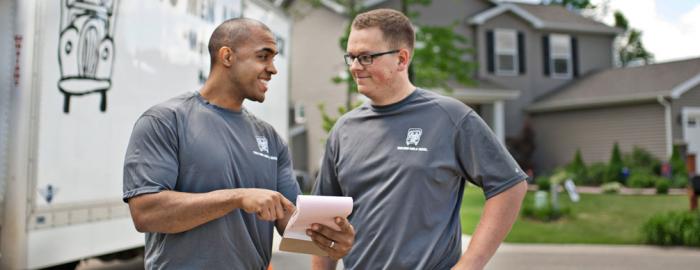Moving a deep freezer may seem like one of those daunting tasks you’d rather avoid, but here’s the good news: with the right approach and a little bit of planning, it’s not only manageable but can be a smooth, efficient process. Whether you’re gearing up for a big move to a new home, reorganizing your garage, or simply giving your space a fresh look, TWO MEN AND A TRUCK has you covered. Here’s 8 simple steps to moving a deep freezer.
What You Need
-
Ratchet Straps
To secure the freezer during transit.
-
Moving Blankets
To cover up the freezer so it does not get scratched.
-
Gloves
To provide a better grip when lifting the freezer.
-
4-Wheel Dollies
At least two, to transport the freezer without carrying it.
-
Tape Measure
To ensure the freezer fits through doorways and hallways.
-
Towels
To clean up any water from the defrosting process.
Step-by-Step Instructions
-
1Step 1Empty the freezer
The first and perhaps most important step in moving a freezer is to empty it completely. A full freezer is not only heavy but also poses a risk of spoiled food. Begin by removing all the food and storing it in another freezer or cooler during transit.
-
2Step 2Defrost the freezer
Defrosting is crucial not just to reduce weight but to avoid water leakage during transport. If ice is left inside, it can melt, leading to potential damage to the flooring or vehicle. Once defrosted, wipe down the interior of the freezer to remove any remaining moisture. This prevents mold and mildew from forming during the move. Cleaning the interior also eliminates any odors that might develop in the freezer.
-
3Step 3Unplug and secure the freezer
Before moving the freezer, unplug it from the power source. It’s important to handle the electrical components carefully to avoid damaging them. Once unplugged, the power cord should be secured to the back of the appliance. Use tape or zip ties to secure the cord so it doesn't get caught or damaged during the move. This simple precaution can prevent tripping hazards and ensure that the cord remains intact for reinstallation.
-
4Step 4Detach your freezer’s components
Inspect the freezer’s door seals and other components during this phase. If the freezer has detachable parts like shelves or drawers, remove them to prevent damage during transport. Any loose or fragile parts can shift and break while the freezer is in transit, so pack them separately if possible.
-
5Step 5Measure doorways, hallways, and entryways
Measure all the doorways, hallways, and staircases the freezer will pass through. Plan your route to ensure the freezer fits through all spaces it will travel through so that you do not have anything holding once moving it has begun.
-
6Step 6Carefully move the freezer
Once the freezer is ready to be moved, get a couple of friends to help lift the freezer onto two 4-wheeled dollies. Have one person lift while the other moves the dollies so that they are properly distributed under the deep freezer. Once everything is set, push the freezer as far as you can until you must lift it to navigate it around another structure or down some steps. Be cautious when navigating stairs or tight spaces as well and be sure to properly communicate with the other person helping you lift the freezer. We also cannot stress enough to use proper lifting techniques (lift with your legs and not your back). Also, grab onto the bottom of the freezer to lift it for more mobility when walking.
-
7Step 7Loading and securing for transport
When loading onto the truck, position the freezer towards the front of the truck so there is better weight distribution. Use ratchet straps to synch down the freezer so it does not move. We also recommend putting moving blankets in between the metal part of the ratch and the freezer so nothing gets scratched.
-
8Step 8After the move
After moving the freezer to its new location, you’ll need to let it settle before plugging it back in. Leave the freezer unplugged for at least 2-4 hours before reconnecting it to a power source. This allows any displaced compressor oil to return to its proper position, which is vital for the freezer's functionality.

Thinking of Moving Yourself?
Think Again!
While moving yourself may seem less expensive... the costs add up.
Do-It-Yourself Moving Costs:
- Truck Rental
- Mileage
- Fuel Charge
- Additional Insurance
- Equipment Rental
(straps, rope, furniture pads, bungee cords, stretch wrap, dollies, etc.)
- Time
- Boxes & Packing Supplies
- Possible Damages
(belongings, relationships, & injuries)
- Recruiting Friends to Help
- Food & Beverages
- Chiropractor Visits
- Packing a Truck
- Learning How to Maneuver a Moving Truck
- Broken Promises
Call TWO MEN AND A TRUCK
We can move as much or as little as you need while fitting your schedule & budget!






